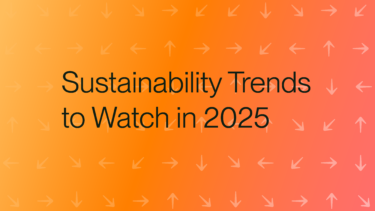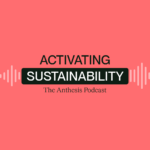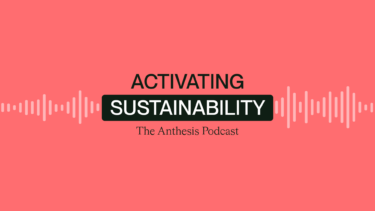
Speakers
Annabelle Stamm – North America Regional Lead
Chris Peterson – Director, North America
Mentioned Links
Sustainability continues to evolve at a rapid pace – regulatory changes, market expectations, and global treaties will make 2025 a pivotal year for organisations across industries. In this episode of our Activating Sustainability series, our host Chris Peterson is joined by Anthesis North America Regional Lead, Annabelle Stamm to discuss some of the sustainability trends to watch in 2025, including recent regulatory shifts, greenwashing, the intersection of climate, nature, and social impact, and more.

Read the transcript
Chris Peterson: Hello and welcome to Activating Sustainability, the Anthesis podcast. I’m your host, Chris Peterson. As this is our first podcast of 2025, we wanted to start by looking at the year ahead, the big trends and thinking that will shape our activities. To dig in on those and share some really valuable perspective, I’m really pleased to welcome for the first time on the podcast, our new Anthesis North America CEO, Annabelle Stam. Annabelle, welcome to the podcast.
Annabelle Stamm: Thank you, Chris. I’m really excited to be here. Thank you for inviting me on.
Chris Peterson: Absolutely, since this is the first time you’re joining the podcast, I wonder if you want to say just a little bit about your background and why you joined Anthesis in the fall.
Annabelle Stamm: Yeah, sure. I’d be happy to. Okay, first off, my name is Annabelle Stamm, I am the managing director of the North American team here at Anthesis. And I’ve been in the sustainability space for two decades now. So it’s really it’s been a passion of mine since the offset. I’ve always really been driven by this notion of purpose and wanting to have impact, but I’ve also always really enjoyed the business side of sustainability.
And to me, it’s always just been something that is logical. It makes business sense. And I’ve always seen it as the risk that it presents, but also the opportunity that it is to organizations. So I’ve really enjoyed dedicating my career to helping companies to unlock that. As you can tell by my accent, I’m based in Madison, Wisconsin.
But I’m from the UK originally. I’ve spent just over a decade living in the States now. And then, yeah, to, to Anthesis. As you mentioned, I am new. I joined the organization four months ago, and it’s absolutely wonderful to be here, and the question that I’ve been asked is, what brought you to Anthesis?
And my response to that has typically been, because it’s Anthesis. I remember when Anthesis first started and exploded onto the sustainability scene. And I have always been so impressed by the work and the quality that the organization put out. And I always really knew Anthesis for the technical side of sustainability.
Somebody recently referred to us as like the technical jock in their corner, and I thought that was such a great description of the company. But the thing that really brought me to Anthesis is really the depth and breadth of expertise and capabilities that the organization has. As I mentioned before I’m purpose-driven and business-oriented and really Anthesis has all of the different tools around strategy, communication, data, like all of the different components that organizations need to be really successful. So it was a place that I was excited to land and feel like I could really have an impact, help companies and drive change.
Chris Peterson: That’s great. Thank you so much. And yeah, we’re really excited to have you on board and those values that have set us importantly on our path. As we look at the year ahead, there’s so much going on, and especially for those of us in the sustainability space, and particularly in North America, where both you and I are sitting whether we’re looking at the horrible wildfires in LA, the snow in New Orleans, the rollbacks on DEI programs, other changes at the federal level.
But obviously also globally, there’s lots of things going on. It can sometimes feel overwhelming, confusing, and worrying. So I’d love it if, through this conversation, we could really dig in on what you’re hearing from CSOs, sustainability teams, and Anthesis colleagues about some of those key trends that are out in the space.
Annabelle Stamm: Absolutely. And yeah, one of the great things about Anthesis is that we’re privileged to work with over 4000 companies across 80 different countries. There’s 1500 experts within the organization. So we hear and see a lot. And the new year always provides a great opportunity to actually pause and reflect and think about where we’re going, where we want to go and what the key trends might be.
Chris Peterson: That’s great. And I know the leadership team Anthesis pulled together. What are some of those big trends that we’re going to use to guide the conversation today, and we’ll definitely link in the show notes. So maybe we’ll dig into each of those one at a time kind of countdown style from 5 to 1.
And the first one in that sequence is the intersection of climate, nature and social impact. And so curious if maybe you could speak to that a little bit in terms of what you’re seeing.
Annabelle Stamm: Yeah I think that this is an interesting and obvious transition to happen. In many ways, because these topics are so intertwined, it really makes sense to think of them together to really maximize the impact that you can have as an organization and the value that you get from your investments.
So as an example, if you think about nature-based solutions, nature-based solutions have the opportunity to offset up to a third of global emissions in a really cost-effective manner. So that also makes them a really crucial component of climate action in addition to the nature benefits and biodiversity that, that can be created there.
Similarly, if you look at social equity through climate and nature solutions, climate action initiatives increasingly are prioritizing topics around social justice, focusing on the opportunities of improving livelihoods of vulnerable communities and addressing inequality as a part of the sustainability efforts.
So they’re really intertwined with the, with these co-benefits and their economic benefits that really come from that as well. A study showed that a third of the world’s GDP is moderately or highly dependent on nature and its services. So protecting this is a key issue for companies to be considering.
So by building out a strategy that focuses on investment and projects that deliver both things like climate resilience and social impact and other pieces, it can really help to maximize funding, bridge funding gaps yeah, really maximizing that, that investment. Yeah, I guess to say in layman’s terms, it really helps you to get the most bang for your buck by thinking of them all together.
One other thing that I’ll say about this topic that I think is an interesting shift that we’re seeing, is that historically, when companies think about their sustainability programs, and many of you will be very familiar with the classic three pillars that we often see around, people, planet, profit, they can be phrased in different ways, and categorizing them into these three separate pillars.
And I think a trend that we may start to see is that we’ll stop thinking of them in these isolated areas and actually really looking at that interconnectedness, again, thinking through ways of maximizing benefits. And I think as a sustainability leader, if you’re able to communicate these issues, no longer in isolation, but as this powerfully interconnected framework, it will really enable you to demonstrate the breadth of impact that your actions are having, really entrenching the business case in some of these things, and again, as I mentioned before, maximizing that investment. Yeah, I think we’re, I think we’re going to see less of this kind of siloed separation or just looking at climate and really thinking about how to maximize that with the climate nature and social pieces all combined.
Chris Peterson: It’s always fascinating to think about, like, how the space has evolved over the last 20 plus years to where we finally get to this kind of comprehensive state with it. But often that can sometimes feel hard to think about how do you pull that together?
Annabelle Stamm: Chris, I’d love your thoughts on this too. Are there any companies, for example, that you would call out as being particularly successful in this space?
Chris Peterson: One that comes to mind is the work that a number of our colleagues are doing with Nestlé and really trying to understand how climate risks are showing up for them and their supply chains and the impact it’s having on the critical inputs into their value proposition in the market.
But then also really looking at it in terms of how do they support the communities they’re working in? How are they ensuring that they’re leveraging nature to do that in a really functional, sustainable way going forward. And so that’s one that comes to mind for me, but it’ll be fascinating to see how these all evolve over time.
Annabelle Stamm: Yeah, I love seeing these examples of really maximizing the benefits.
Chris Peterson: Yeah. And I love that bang for the buck concept. Cause I think so much of this is like how do we maximize our investments? There’s so much to get done. How do we do that in a way that makes the most sense?
Annabelle Stamm: Exactly.
Chris Peterson: That’s great. I’m going to keep us moving through these. The second one is that 2025 marks the halfway mark to 2030, if I’ve got my math right. But that says that we are hitting those interim targets and looking at how we’re doing. So curious kind of how this showed up for you all, or how you’re hearing people thinking about this time.
Annabelle Stamm: Yeah. 2025. I think it’s going to be really interesting. It is particularly important, like you mentioned, it’s a halfway point towards the sustainability targets that was set out in the UN’s Decade of Action. It’s also a year that many companies have set as the point for their sustainability goals, science-based targets.
There are a lot of goals that are coming up this year. So it’s going to be interesting to see what comes out and what kind of progress that we’re seeing. If we look back and take a moment to pause and reflect at some of the change that we’ve been seeing, like some of the progress and the uptake is astronomical.
If you think about the Science Based Targets initiative, for example, back in 2015, there were only 10 companies setting science-based targets. By 2020 that number had gone up to 546, which I remember at the time thinking was incredibly exciting . Right now it is over 7,000 so just the speed of their transition of the uptake and the importance that companies are seeing in the need to be decarbonising is huge right now.
If you don’t have a science-based target as a large or medium-sized company, you stand out as a laggard. Not to mention the number of your customers that have set targets for their scope three that you’re then caught up in. So you’re actually beginning to start Risking revenue and customer relationships that you have. That all being said, though, the progress is nowhere near far enough as it needs to be the saying is that saying, what is it?
So shoot for the moon, and even if you miss your land among the stars, I don’t think we’re anywhere near the moon right now. But our feet are off the ground and that’s pretty exciting. I was thinking we’re more like the Wright brothers right now, we’re like just getting onto the airplane and getting off the ground.
But there’s so much work that still needs to be done, and as a society, we’ve never needed to accomplish anything as big is this in the speed that it needs to be done. So, it’s, it is understandable that there are going to be challenges and setbacks a lot along the way.
And I do expect to see that there will be many companies missing their targets or not accomplishing everything that they wanted to set out to do. And no one wants to celebrate failure or missing things, but at the same time, I think it’s really important to be applauding the companies that are really out there setting these ambitious targets and taking us on that journey and sharing along the way that the wins and the losses and the challenges and what they’re seeing.
But I do think that there’ll be a few misses this year. I think it’s a mixture of over ambitious targets the systemic challenges of some of these things. Last year, we saw some tightening economic issues and of course, some of the political uncertainty. So all of these things are challenging and can result in delays and timelines and other setbacks.
An example, again, would be looking at CPGs with plastic recycling and the commitments that they have there and just the need for full systemic change to be able to support that to happen and how no one company can really do this alone. Yeah, I think that the most important thing along this journey is really being transparent, setting up as best as you can.
We’re already starting to work with a number of companies, or we have already been working, this isn’t just a thing this year, of helping to reassess targets and think about the next 5-10 years. And I think we’re going to see changes in both directions.
We’re going to see some that are upping the ante and some that are needing to withdraw a little bit based on being pragmatic to some of the things that they see. And again, just coming back to that earlier point, I think it’s just important to show the thought process, be transparent, take your stakeholders along with you on the journey.
Chris Peterson: Yeah, no, I love it. And I don’t know how you view it, but I always find it really interesting to look at. Say there’s really ambitious goals that are anchored in pragmatic action. And that sense of really embracing the reality of where we are. And it feels like there’s a little bit of that’s going to be happening this year that will kind of differentiate those companies of we set a goal, but we want the accolades but not do the work versus those that are like, we’ve been doing the work, we’re just not moving as fast as we are.That kind of distinction.
Annabelle Stamm: yeah. I think there’s going to be a real sorting between those two.
Chris Peterson: Yeah. And actually, why don’t we jump to number two on the list, which is green claims and greenwashing. I’m just curious kind of what you’re seeing in that space and how that’s likely to evolve this year.
Annabelle Stamm: Okay Hear me out on this one, but I have always gotten a bit of kick out of greenwashing like I said, bear with me.
Chris Peterson: You’re going to have to explain that one.
Annabelle Stamm: Yeah, don’t put me on the bonfire yet. Okay. So, the reason why I’ve always gotten a bit of a kick out of seeing greenwashing is because companies are saying we see the business value in sustainability.
We know that consumers want to buy from green companies. So let’s put something on our label to attract them. Now, obviously misleading consumers is absolutely not okay, it’s morally wrong and you are opening up your organization to a whole slew of regulatory penalties and damage to brand credibility, not to mention the fact that you’re having zero impact on sustainability initiatives just by putting it on a label.
So positioning credible green claims backed by science and third-party verification is really crucial, and it’s going to get more so in 2025 because there’s going to be heightened enforcement on the EU Green Claims Directive, and we expect to see similar policies worldwide. In addition to the regulatory piece, we also expect to see continued consumer backlash against brands who are caught overstating sustainability achievements.
They’re increasingly demanding certifications and standards to verify claims. The consumers are getting really savvy in this space. So brands really need to focus on authenticity, on, on transparency and be leveraging third-party validation to navigate these challenges effectively. So a recommendation anyone who is putting claims out there I really encourage you to look at it and just be confident that you can back that up going into 2025.
Chris Peterson: Okay. I think you pulled that back out of the fire. So well done and appreciate where you’re coming from with that. As we talk about language, it feels like it’s been an interesting time to see a lot of acronyms getting politicized especially the politicization that we’re seeing particularly here in North America around DEI and ESG. And that tension of needing to disclose more in Europe and potentially re-wording or being more sensitive here in North America and curious how you’re seeing clients balance that or advising people’s thoughts within that space.
Annabelle Stamm: Yeah it’s a really interesting question and definitely something that, that we’re seeing, and even without the European regulations, companies in North America, many of them are not going to stop doing the work over the next four years. Climate risk is still business risk. They still see the different risks and opportunities and the importance of the different initiatives that, that they’re working on.
However, I do think that there is going to be a an uptick in pressure of finding new ways of communicating this work in language such as ESG and DEI, as you’ve mentioned, have become highly politicized. And, I don’t see what the replacement is for that yet. I think people are scrambling to think of new language, but I do think that there are new ways that you can think about phrasing and communication.
So as an example in a recent report from our colleagues at Revolt who are part of Anthesis, put out a report that showed that centrist language was found to resonate with audiences across the political spectrum. And it’s a really fascinating report. It really looks at if you can tap into deep-seated human values, like things like love freedom, family you can make these issues appeal to more universal category and make them less partisan.
So a couple of examples. If you think about the climate space, a very politicized topic, you have on one hand, fighting for climate justice for all. Instantly, it gets very politicized and throws up challenges. If you move that along to securing a safe climate for your family’s future.
Who doesn’t want a safe climate for your family’s future? It’s just the tweaking of the language. Another one would be supporting marriage equality for the LGBTQ plus community. Again very polarized, politicized, challenging. However, if you transition that to supporting the freedom to love whoever you want.
Who doesn’t love? Love is love. It instantly softens, it softens and engages people around, around the language. So I do think companies are going to shift and think of new ways about communicating the work that they do. I really encourage everyone to check out that report. It’s a fun read.
It’s called ‘Poking the Bear’ and it takes you through how you can bear proof your strategy. So it’s a great read. Another one that we have coming out that I would encourage is called the ‘Cost of Silence’. And this is looking at the business case for sustainability action and communicating on sustainability.
So if anyone here listening is going to be at GreenBiz, reach out because we’re going to be hosting a session on this because this is going to be a important topic to help companies to navigate through 2025 and the next four years of, how do they engage and bring together different stakeholders and what is a highly politicized and dynamic time.
Chris Peterson: That’s great. Yeah, and we’ll provide links to all of those and the sessions at GreenBiz. So thanks for sharing this. Maybe moving on to the 3rd that we had skipped, which is the emerging regulations within the Voluntary Carbon Market and how that space has shifted. And I know this changed a lot in Baku, is one of the few kind of really positive things that came out of COP29. So curious if you could speak a little bit to what you’re seeing there.
Annabelle Stamm: Yeah, I think that the work that’s going on there to create, stronger regulatory frameworks and standards that really harmonize practices across the voluntary and compliance markets will really help to assure accountability and impact and really give the market trust in that space. In the past, there have been some criticisms and some challenges
in the market, but we’ve really seeing that change because of this additional stringency that’s being put on, but also the fact that offsets are increasingly being used in the right way and as was intended. Carbon offsets aren’t designed to be that, to do something instead of decarbonization.
It’s really seen as a great bridging strategy that can compliment and support the work that you’re doing on decarbonization activities. They’re also a great solution for hard to abate emissions, and they also can come with some pretty compelling co benefits, which is one of the things I really enjoy about the carbon offset space, such as biodiversity conservation, protection of wildlife habitats, and many social benefits and improved community health and well being.
So these co benefits on top of supporting you around your climate goals can really complement your brand strategy and marketing efforts. So again, it comes back to that. bang for your buck win scenario. One of the things that I expect to see more of in 2025, so as a result of this increased stringency and demand, we’re seeing a real uptick in demand for carbon offset offsets, and through that, we’re starting to see more of a supply demand gap for high quality credits, which is driving up investment in things like pre-purchasing or off take agreements.
So companies are looking to secure long-term carbon offsets essentially to ensure that they have access to the availability at the price point and the quality to meet their future demands. So I think that I already see that as a trend and that is a trend that I expect to see increase through 2025.
Chris Peterson: Yeah. It makes sense too. As people start to miss targets, et cetera, trying to think about Oh, this wasn’t as easy as we thought. What are some of those other levers to get us there.
Annabelle Stamm: Exactly.
Chris Peterson: And then just conscious of the time, I’m going to take us to the number one that was on the list, which was preparing for regulatory shifts in 2025. And I know that’s a big topic, but would love to hear what’s particularly top of mind for you and the conversations you’re having.
Annabelle Stamm: Yeah, there’s a reason why it’s number one, right? This is a really hot topic. Anyone working in sustainability right now who is caught under the different regulations is really feeling it. And 2025 is an exciting year. We’re going to be seeing the first CSRD reports coming out shortly, a number of different initiatives and I think what’s interesting about the regulatory space is it’s really forcing a lot of companies to take a long, hard look in the mirror and assess their sustainability risks and opportunities. I think in the past decade or so, companies have reacted to the concept of sustainability quite differently. Some have stepped out and look to be leaders.
Some have known that it’s an issue, but I’ve buried their heads in the sand and some have actively pushed against it. So what regulations like CSRD getting organizations to do is to really can pause and reflect and actually think through to their business. Like, where are there these impacts?
Where are the risks and opportunities to our business? And some of the conversations that it’s thrown up have been fascinating and incredibly important. As an example, there was one construction company that I was advising and we were talking through climate risk. And one of the things that came up is the drastic drop in productivity that there is for every temperature degree increase that there is. So not only does that create real concerns for the workforce, but it causes delays in the projects. Now, if there are delays in the projects, that means that they can’t get the equipment off site. If they can’t get the equipment off site, they can’t get it to the new site, which means that they can’t start the new project.
Often in contracts, they will have agreements in there to start at certain times delivered by certain times, and there are financial penalties associated with this. Now, this isn’t going to show up as like a climate risk line item, but this is a real tangible risk that this company is facing as a result of climate change.
And they’re already starting to see impacts from this and having to put in water stations and things like that. So again, this is all to say that I think with the regulatory shifts, there are many companies that, like I said, taking a long hard look in the mirror and really beginning to understand where there are these risks and opportunities to their business.
I will probably butcher this Jean Paul Sartre quote, but I’ve always loved it through my career, which is essentially like once we know and we are aware. We are responsible for our action and inaction and we can choose to do something about it or ignore it. And I think that’s what’s been really interesting around this push around regulations is it’s really creating that awareness around these topics.
Chris Peterson: That’s great. And maybe I know we’re going to do like a deep dive session in February on the new administration in the U. S. how it’s impacting sustainability teams and share insights on approaches for navigating it all. But kind of as it’s the elephant in the room, I’d love to hear what are some of the conversations you’re having around that from a regulatory perspective and how CSOs and their teams are approaching the current moment.
Annabelle Stamm: It’s, it’s an interesting time for companies to be navigating right now. And I think it touches upon a lot of the key trends that we spoke to there around, how to talk about sustainability and green claims and regulations and all of those pieces, many companies right now are experiencing uncertainty and trepidation for example, with the Climate Disclosure Rule potentially being rolled back. Will portions of the IRA be repealed? We’ve already seen Trump sign an executive order that’s pausing wind energy development on federal lands and waters. This change in administration will have its own impact. But that being said, the issue here is not going to go away.
The sustainability movement has been gaining momentum really over the past 50 years like I mentioned before, sustainability risk is business risk and while there may be a change in leadership that is not prioritizing it in the same way, the issues are still happening.
People are incredibly aware of climate change in a way that they weren’t a few years ago. And I think back to 2016, there was still a lot of debate around the topic, and I still don’t think many of my friends or family fully understood what I did as a career or why it was important. However, now it’s very difficult to deny the importance when you can see what’s happening when you have the fires in California, the flooding in Valencia we have snow in Florida, like you mentioned in, in your intro.
So yeah, companies are really seeing that the risks and opportunities that this presents and on the opportunities piece, just to mention, one thing that we know about America is that it will follow the money and America is incredibly good at being entrepreneurial and an innovating and we know and what we’ve seen is that what is good for the planet is good for the bottom line.
So I think that horse is already out. If I can use that, say ing. A recent survey, I saw this just this week, there was a recent survey of CEOs that showed that one in three CEOs reported that climate friendly investments that they’ve made over the past five years have resulted in increased revenue. The same group when surveyed said two thirds of them said that sustainability initiatives had either reduced costs or had no significant impact.
So again, coming back to that business value, the risks, the opportunities that organizations are seeing, I just don’t see how a shift in leadership changes the importance of these pieces. And then I just say last but not least as well as like many companies here. They operate on the global stage you know being very driven by the regulations that are coming through Europe such as CSRD. And even if you’re not directly impacted by those regulations yourselves, you are often indirectly impacted as a result of being within the supply chain of a company that is. But also at a state level as well, there are many initiatives that companies will still be needing to look to and that will still be driving through the agenda.
For example, California, the fifth largest economy in the world, you’re still going to be needing to comply with state climate legislation there. So yeah, I, as you can see, there’s a lot I could speak to a lot more. That’s just some of the pieces. I’m really glad that we’re doing a full webinar on this because it’s an important topic right now and there’s lots that can be discussed.
Chris Peterson: Absolutely. Yeah. So much will evolve over time. And I think this has been great to get that overview of the trends. And maybe I’ll just round those off quickly. And I would love to hear your thoughts around what can people do with that? Right? So when we think about the 5 trends, the preparing for regulatory shifts in 2025, green claims and greenwashing, regulating the voluntary carbon market, the interim targets to 2030, and the intersection of climate nature and social impact. We’ve covered a lot of ground and would love to hear if there’s a couple of kind of tactical things that you would recommend listeners kind of take from this conversation.
Annabelle Stamm: Yeah, on the tactical side, thinking about direction and prioritization, I think it’s exactly that, for any organization, it’s about understanding your priorities and building a roadmap from there. You can’t do it all and you definitely can’t do it all at once. So just making sure that you have the fundamentals down:
your emissions, your targets and materiality assessment, all of these different components then really help you to prioritize figure out what’s most important to your organization and then begin to engage stakeholders and drive change.
Chris Peterson: Well, that’s wonderful. And maybe one last question is if there was one action you’d recommend the listeners to take coming out of this conversation, what would that be?
Annabelle Stamm: All right, that’s a good question. My advice, keep on keeping on. There is a lot of good work to be done. Let’s not get distracted now.
Chris Peterson: I love it. Great spot to finish that off. So thank you so much. Really appreciate your time and insight here.
Annabelle Stamm: Thanks, Chris. My absolute pleasure.
Chris Peterson: And thank you all for listening. We really appreciate it. We’re really excited about the year ahead for this podcast and have an exciting lineup of quick reflections from key events and developments in our space, as well as deep dive discussions like this one to really get to the heart of the issues driving sustainable performance.
If you have any feedback or suggestions, as always, we’d love to hear from you. As mentioned, we will post all the relevant links mentioned in today’s show in the show notes, and you can access the full and Anthesis 2025 trends report on our website at anthesisgroup.com. As well as Annabelle mentioned will be a GreenBiz and hope to see many of you there.
And as always, we can be reached at First.LastName@anthesisgroup.com. Thanks again for listening and all the best to you, your teams and your families for the year ahead.
Inside this episode
- What major regulatory shifts should businesses prepare for in 2025?
- How can companies navigate increasing scrutiny on green claims and greenwashing?
- What changes are shaping the voluntary carbon market, and how should businesses respond?
- As we reach the 2030 halfway mark, how are companies tracking against their sustainability targets?
- Why is the intersection of climate, nature, and social impact becoming more critical for businesses?
- How are companies in North America balancing these sustainability trends alongside political shifts?
If you have any feedback on the podcast, get in touch with our host Chris Peterson at: Chris.Peterson@anthesisgroup.com















